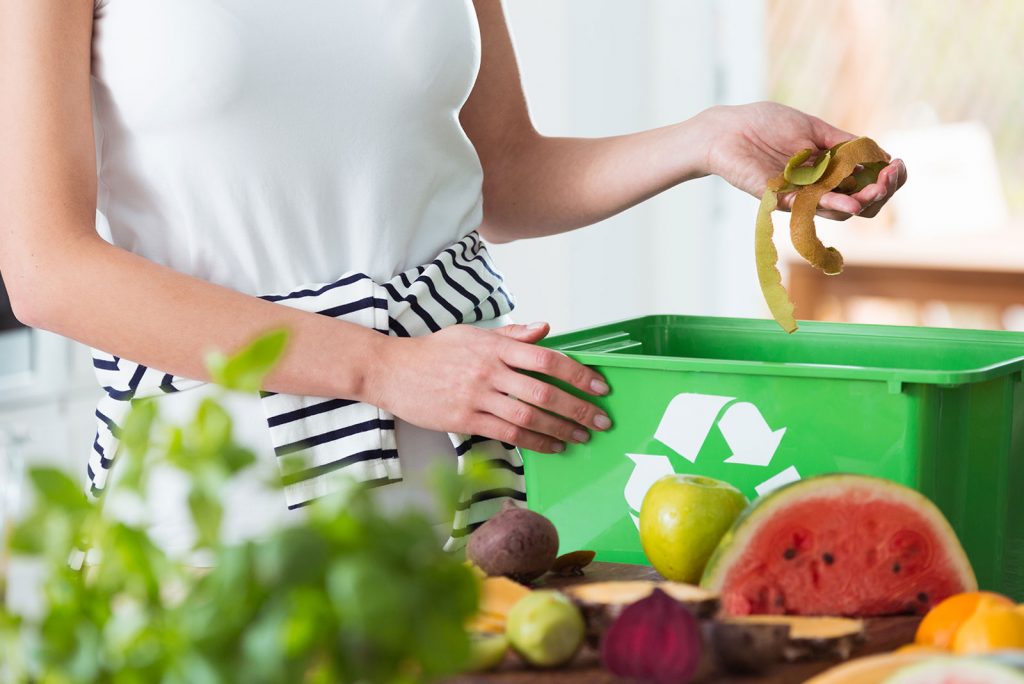
What do you do with banana peels, egg shells, vegetable trimmings, and other food scraps? How about yard waste? When we think about greenhouse gases, we typically think of carbon dioxide emissions. But when food and other organic materials break down in landfills, they produce methane, a greenhouse gas that is 72 times more powerful than carbon dioxide in its effect on global warming (over a 20 year period).
That’s where the power of composting comes in, allowing us to transform food scraps and yard waste into rich, fertile soil. Did you know that almost half of the trash that goes to landfill in the United States consists of organic waste that could be composted? If composting sounds like a great idea—that’s because it is! Not only does composting reduce waste, methane emissions, and soil erosion, it helps create healthy soil to support growth of plant life. Plus, compost reduces the need for chemical fertilizers or pesticides.
Composting at home is easier than you think. And, if done right, it won’t smell or attract pests. Take a look at composting options that you can tackle in your backyard and even inside your home.
Composting basics
According to the Environmental Protection Agency (EPA), composting starts with 3 ingredients:
- Browns—dry materials like dead leaves, branches, and twigs provide carbon for the compost (detailed list below)
- Greens—yard clippings, vegetables, and fruit waste provide nitrogen for the compost (detailed list below)
- Water—Moisture helps break down organic matter
A compost pile should have equal amounts of browns to greens, in alternating layers, and consisting of materials of varying sizes. Before getting started, consider getting a kitchen countertop food scraps container or pail that you can empty at night.
For at-home composting, here’s what not to use and why (though some may be accepted by community composting programs):
- Diary, eggs, meat, fish scraps, fats, grease, oils—to avoid odor and pest issues
- Pet waste or soiled litter—might contain harmful parasites, bacteria, or viruses
- Diseased or insect-ridden plants—disease or insects can remain in compost and be transferred to other plants
- Yard trimmings that have been treated with chemical pesticides—might kill beneficial composting organisms
Tip: You may want to avoid adding garlic and onions to your compost, as they can repel earthworms that help fertilize the soil in gardens.
What to compost:
| Greens | Browns |
|---|---|
| Fruits and vegetables | Dead leaves |
| Eggshells | Branches and twigs |
| Coffee grounds | Shredded newspaper |
| Tea bags | Cardboard |
| Nut shells | Paper |
| Yard trimmings | Hay and straw |
| Grass clippings | Sawdust |
| Houseplants | Wood chips |
| Leaves | Cotton and wool rags |
| Dryer and vacuum cleaner lint | |
| Hair and fur | |
| Fireplace ashes |
Composting in your backyard
Using greens (nitrogen), browns (carbon), and water, (plus air) to create compost in your backyard is also called “warm composting.” Together, the nitrogen, carbon, water, and air feed microorganisms that help speed the breakdown. In warm weather, the process can produce compost in just 1-3 months.
Aim to collect about 3 feet worth of greens and browns to start. Choose a dry and shady spot in your backyard near a water source (like a hose) for your compost pile. Alternate layers of wet greens and dry browns while ensuring larger pieces are shredded or chopped. Sprinkle water over the layers as you go, especially on the dry brown layers. If the pile gets too dry, add more greens and water. If it gets too wet, add more browns. If the pile gets too wet it can drown the needed microorganisms and start to rot and smell. Your compost is “cooking” if it feels warm to the touch in the middle of the pile.
Next, turn it regularly—about once a week during growing season—with a garden fork to help add air to the compost pile and allow it break down faster. It also prevents materials from getting too wet and matted and developing an odor. Stir thoroughly.
Once your compost pile no longer feels warm and has turned dark, dry, and crumbly—you’ve got compost ready for use in your garden! Do keep some of this compost material in your compost heap so you can continue mixing green waste into it, burying it under 10 inches of compost material.
Another option when it comes to composting in your backyard is called cold composting, and it takes longer—likely about a year or more. It’s as simple as collecting compost materials in a pile or a bin and letting nature have its way. The material will slowly break down over time.
Public, private, and local composting programs
At least 200 cities in the United States participate in food composting. Communities across the countries in 18 states have some sort of residential food scrap recycling program serving more than 2.3 million households. So depending on where you live, you may have curbside food waste collection or be able to find drop-off programs nearby. Clearway Community Solar recently









